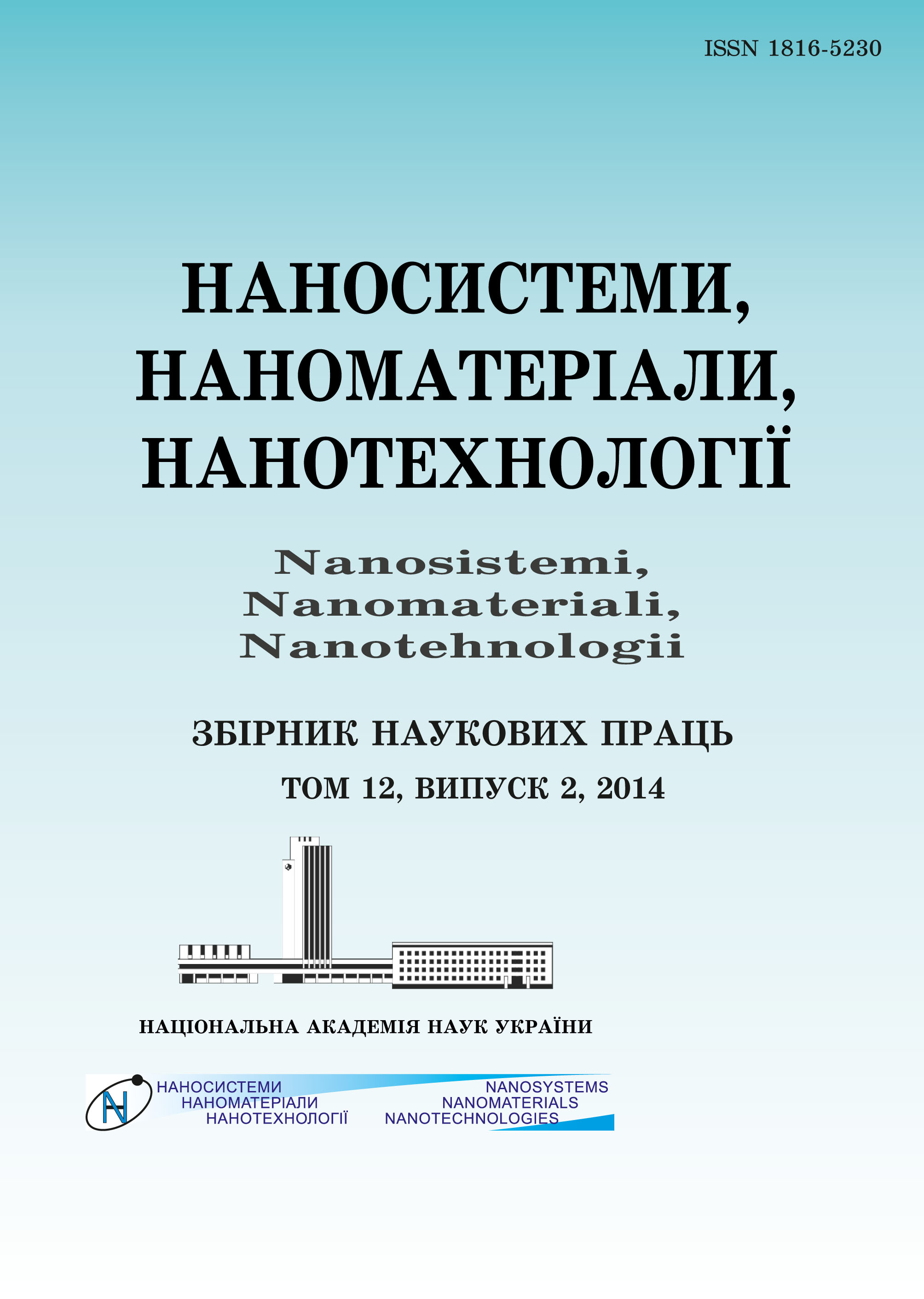|
|
|||||||||
 |
Year 2023 Volume 21, Issue 3 |
|
|||||||
|
|||||||||
Issues/2023/vol. 21 /Issue 3 |
B. Turko, V. Vasiliev, and V. Kapustianyk
Electrophysical Properties and Thermal Conductivity of Reduced Graphene Oxide–ZnO Composite
569–574 (2023)
PACS numbers: 06.60.Mr,44.35.+c,66.70.Lm,72.80.Tm,77.22.Ch,81.05.Qk,85.30.De
The thermal conductivity of the composite materials based on the commercial ZnO micropowder with/without reduced graphene oxide (0.5 vol.%) powder dispersed in the polymethylsiloxane (silicone oil) is measured using the radial heat-flow method. The thermal conductivity of the composite material based on the commercial ZnO micropowder with an average particle size of 50 µm is found to be of 1.2 W/(m?K). The thermal conductivity of the composite material on the base of ZnO and reduced graphene oxide is found to be of 7.5 W/(m?K). At room temperature, the values of the dielectric permittivity at the measuring electric-field frequencies of 50 Hz and 1 MHz as well as the specific bulk electrical resistance for the composites are obtained. The large values of the thermal conductivity and the dielectric permittivity as well as lower specific bulk electrical resistance of the reduced graphene oxide–ZnO composite are associated with the contribution of reduced graphene oxide, the Maxwell–Wagner–Sillars interfacial polarization, and formation of the microcapacitor structures. It is also necessary to take into account that water could be adsorbed onto the powders’ surface in the process of composites’ fabrication. The high performance of reduced graphene oxide–ZnO composite synthesized by the simple and facile process in this work shows promising potential in thermal control of the electronic devices
Key words: reduced graphene oxide, zinc oxide, composites, thermal conductivity, dielectric constant, specific bulk electrical resistance.
https://doi.org/10.15407/nnn.21.03.569
References
- W. Xing, Y. Xu, C. Song, and T. Deng, Nanomaterials, 12: 3365 (2022); https://doi.org/10.3390/nano12193365
- M. T. Phuong, P. V. Trinh, N. V. Tuyen, N. N. Dinh, P. N. Minh, N. D. Dung, and B. H. Thang, J. Nano- Electron Phys., 11: 05039 (2019); https://doi.org/10.21272/jnep.11(5).05039
- C.-N. Hsu, K.-W. Lee, and C.-C. Chen, Processes, 9: 847 (2021); https://doi.org/10.3390/pr9050847
- M. Sang, J. Shin, K. Kim, and K. J. Yu, Nanomaterials, 9: 374 (2019); https://doi.org/10.3390/nano9030374
- D. Han, Y.-H. Zhao, Y.-F. Zhang, and S.-L. Bai, RSC Adv., 5: 94426 (2015); https://doi.org/10.1039/C5RA16780A
- X. Mu, X. Wu, T. Zhang, D. B. Go, and T. Luo, Scientific Reports, 4: 3909 (2014); https://doi.org/10.1038/srep03909
- R. Kamatchi and K. G. Kannan, International Journal of Renewable Energy Research, 8: 313 (2018); https://doi.org/10.20508/ijrer.v8i1.6766.g7305
- Y. Zeng, T. Li, Y. Yao, T. Li, L. Hu, and A. Marconnet, Adv. Funct. Mater., 29: 1901388 (2019); https://doi.org/10.1016/j.jallcom.2010.03.076
- H. Mandhare, D. P. Barai, B. A. Bhanvase, and V. K. Saharan, Materials Research Innovations, 24: 433 (2020); https://doi.org/10.1080/14328917.2020.1721809
- S. Biswas, S. Singh, S. Singh, S. Chattopadhyay, K. K. H. De Silva, M. Yoshimura, J. Mitra, and V. B. Kamble, ACS Appl. Mater. Interfaces, 13: 23771 (2021); https://doi.org/10.1021/acsami.1c04125
- B. I. Turko, V. Â. Kapustianyk, V. P. Rudyk, and Y. V. Rudyk, J. Nano- Electron. Phys., 8: 02004 (2016); https://doi.org/10.21272/jnep.8(2).02004
- B. Kolade, K. E. Goodson, and J. K. Eaton, J. Heat Transf., 131: 052402 (2009); https://doi.org/10.1115/1.3013831
- U. Ozgur, X. Gu, S. Chevtchenko, J. Spradlin, S. Cho, H. Morkoc, F. H. Pollak, H. O. Everitt, B. Nemeth, and J. E. Nause, J. Electron. Mater., 35: 550 (2006); https://doi.org/10.1007/s11664-006-0098-9
- D. I. Florescu, L. G. Mourikh, F. H. Pollak, D. C. Look, G. Cantwell, and X. Li, J. Appl. Phys., 91: 890 (2002); https://doi.org/10.1063/1.1426234
- C. F. Klingshirn, B. K. Meyer, A. Waag, A. Hoffmann, and J. Geurts, Zinc Oxide. From Fundamental Properties to Wards Novel Applications (New York: Springer: 2010), p. 359 (in German).
- Z. Chen, Y. Liu, L. Fang, P. Jiang, and X. Huang, Appl. Surf. Sci., 470: 348 (2019); https://doi.org/10.1016/j.apsusc.2018.11.150
- A. Bhaumik and J. Narayan, J. Appl. Phys., 120: 105304 (2016); https://doi.org/10.1063/1.4962210
- W. Tuichai, A. Karaphun, and C. Ruttanapun, Materials Research Bulletin, 145: 111552 (2022); https://doi.org/10.1016/j.materresbull.2021.111552
- D. Wang, X. Zhang, J.-W. Zha, J. Zhao, Z.-M. Dang, and G.-H. Hu, Polymer, 54: 1916 (2013); http://dx.doi.org/10.1016/j.polymer.2013.02.012
- S.-Y. Lo, A. Lo, L. W. Chong, L. Tianzhang, L. H. Hua, and X. Geng, Modern Physics Letters B, 10: 921 (1996); https://doi.org/10.1142/S0217984996001048
- Y. Otsubo, KONA Powder and Particle Journal, 15: 43–43 (1997); https://doi.org/10.14356/kona.1997009
- U. Ozgur, Y. Alivov, C. Liu, A. Teke, M. Reshchikov, S. Dogan, V. Avrutin, S. Cho, and H. Morkoc, J. Appl. Phys., 98: 041301 (2005); https://doi.org/10.1063/1.1992666
 This article is licensed under the Creative Commons Attribution-NoDerivatives 4.0 International License ©2003—2023 NANOSISTEMI, NANOMATERIALI, NANOTEHNOLOGII G. V. Kurdyumov Institute for Metal Physics of the National Academy of Sciences of Ukraine. E-mail: tatar@imp.kiev.ua Phones and address of the editorial office About the collection User agreement |